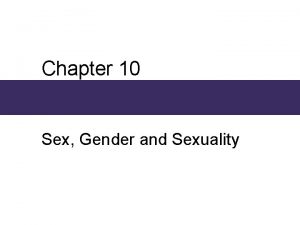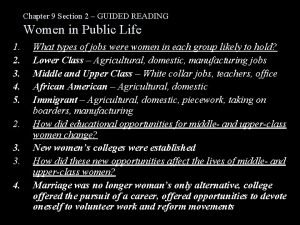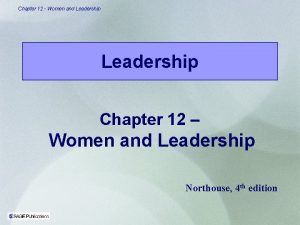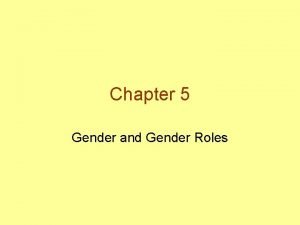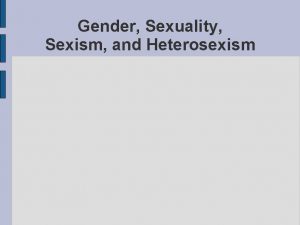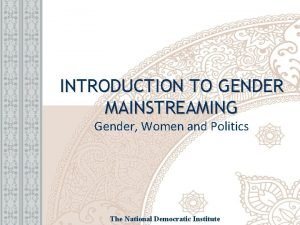Chapter 15 Gender and Leadership Overview Women and



























- Slides: 27

Chapter 15: Gender and Leadership

Overview ÷ Women and Leadership Perspective ÷ The Glass Ceiling Turned Labyrinth ÷ Evidence of the Leadership Labyrinth ÷ Understanding the Labyrinth ÷ Gender Differences in Leadership Styles and Effectiveness ÷ Navigating the Labyrinth Peter G. Northouse, Leadership: Theory and Practice, Seventh Edition. © 2016 SAGE Publications, Inc.

Gender and Leadership Approach Description Historical View ÷ Gender and Leadership ® Researchers ignored issues related to gender & leadership until the 1970 s ® Scholars started by asking “Can women lead? ” ® Changed by women in leadership • Presence of women in corporate & political leadership • Highly effective female leaders – Pepsi. Co’s CEO, Avon’s CEO, General Ann Dunwoody, etc. Peter G. Northouse, Leadership: Theory and Practice, Seventh Edition. © 2016 SAGE Publications, Inc.

Gender and Leadership Approach Description Historical View ÷Current research primary questions ® Do men and women lead differently? ® Are men more effective leaders than women? ® Why are women underrepresented in elite leadership roles? Peter G. Northouse, Leadership: Theory and Practice, Seventh Edition. © 2016 SAGE Publications, Inc.

The Glass Ceiling Turned Labyrinth ÷Women ®Currently outnumber men in higher education - 57% of bachelor’s degrees, 60% of master’s degrees, more than 50% of doctorates, nearly half of professional degrees (Catalyst, 2014 c) ®Make up nearly half of the US labor force - 46. 8% ®Still are underrepresented in upper echelons of America’s corporations & political system Peter G. Northouse, Leadership: Theory and Practice, Seventh Edition. © 2016 SAGE Publications, Inc.

The Glass Ceiling Turned Labyrinth ÷ Women ® Occupy more than half of all management and professional positions and a quarter of all CEO positions (U. S. Bureau of Labor Statistics, 2013) ® Hold only 14. 4% of highest titles in the Fortune 500 ® Represent only 4% of Fortune 500 CEOs (Catalyst, 2014 c) ® Hold only 16. 9% of Fortune 500 board seats Peter G. Northouse, Leadership: Theory and Practice, Seventh Edition. © 2016 SAGE Publications, Inc.

The Glass Ceiling Turned Labyrinth ÷ Women in Politics ® 99 of the 535 seats in the US Congress = 18. 5% ® 20%: Senate; 18. 2%: House of Representatives ® Women of color occupy just 30 seats (Center for Women and Politics, 2014 a, b) ® World average of women’s representation in national legislatures or parliaments is 21. 9%. The United States is ranked 84 th out of 189 countries (Inter-Parliamentary Union, April 2014). ® High-ranking US women military officers = 6. 9% ® (U. S. Dept. of Defense) Peter G. Northouse, Leadership: Theory and Practice, Seventh Edition. © 2016 SAGE Publications, Inc.

8 The Gender Gap in Leadership ÷ Global phenomenon whereby women are disproportionately concentrated in lower-level and lower-authority leadership positions than men. (Powell & Graves, 2003) ÷ Three types of explanations Peter G. Northouse, Leadership: Theory and Practice, Seventh Edition. © 2016 SAGE Publications, Inc.


Understanding the Labyrinth 1. Human Capital Differences ÷ Pipeline Problem – Women have less education, training, and work experience than men resulting in a dearth of qualified women. ÷ Pipeline is not empty but leaking – Explanation that women haven’t been in managerial positions long enough for natural career progression to occur (Heilman, 1997) ; not supported by research. ÷ Division of labor – Explanation that women self-select out of leadership tracks by choosing “mommy track” positions that do not funnel into leadership positions (Belkin, 2003; Ehrlich, 1989; Wadman, 1992); not supported by research (Eagly & Carli, 2004). Peter G. Northouse, Leadership: Theory and Practice, Seventh Edition. © 2016 SAGE Publications, Inc.

Understanding the Labyrinth ÷Women ® do have somewhat less work experience and continuity than men, largely due to disproportionate responsibility women assume for child rearing and domestic duties ® respond to work-home conflicts by not marrying, not having children, becoming “superwomen, ” taking leaves of absence or working part time ® who use flextime and workplace leave are often marginalized; taking time off from a career makes reentry difficult (Williams, 2010) Peter G. Northouse, Leadership: Theory and Practice, Seventh Edition. © 2016 SAGE Publications, Inc.

Understanding the Labyrinth ÷ Women ®occupy more than half of all management & professional positions (Catalyst, 2014 c) but have fewer developmental opportunities ®fewer responsibilities in the same jobs as men ®are less likely to receive encouragement, be included in key networks, and receive formal job training than their male counterparts ®confront greater barriers to establishing informal mentor relationships ®Are more likely to be put in precarious leadership situations associated with greater risk and criticism Peter G. Northouse, Leadership: Theory and Practice, Seventh Edition. © 2016 SAGE Publications, Inc.

Understanding the Labyrinth 2. Gender Differences in Leadership Styles and Effectiveness ÷ Contrary to stereotypical expectations, women leaders aren’t less task oriented or more interpersonal than men leaders. ÷ Women do lead in a more participative manner than men. ÷ Adaptive style because women are devalued when they lead in a masculine manner, occupy a typically masculine role, or when evaluators are male Peter G. Northouse, Leadership: Theory and Practice, Seventh Edition. © 2016 SAGE Publications, Inc.

Understanding the Labyrinth ÷ Transformational leadership ® Women’s styles tend to be more transforma-tional than men’s ® Even as transformational leaders, they are valued less than men ® Women engage in more contingent behavior than men Peter G. Northouse, Leadership: Theory and Practice, Seventh Edition. © 2016 SAGE Publications, Inc.

Effectiveness of Male and Female Leaders ÷ Men and women equally effective overall ÷ Men and women more effective in roles congruent with their gender ÷ Women less effective than men when role is masculinized (military), when supervising large numbers of men, or when rated by men ÷ Somewhat more effective in education, government, social service; substantially more effective in middle management Peter G. Northouse, Leadership: Theory and Practice, Seventh Edition. © 2016 SAGE Publications, Inc.

Commitment to Employment and Motivation to Lead ÷ Men and women show same level of identification and commitment to ÷ ÷ paid employment roles Men and women both view roles as workers as secondary to partner and parent roles Women less likely to promote themselves for leadership positions Women less likely to emerge as group leaders; more likely to serve as social facilitators Men more likely to ask for what they want; Women less likely to negotiate or self-promote and receive more backlash when they do Peter G. Northouse, Leadership: Theory and Practice, Seventh Edition. © 2016 SAGE Publications, Inc.

Understanding the Labyrinth 3. Prejudice ® gender bias stemming from stereotyped expectations – “women take care and men take charge” ÷ Stereotypes = cognitive shortcuts that influence the way people process information regarding groups and group members. ÷ Gender stereotypes include beliefs about the attributes of men and women and prescribe how men and women ought to be. Peter G. Northouse, Leadership: Theory and Practice, Seventh Edition. © 2016 SAGE Publications, Inc.

Understanding the Labyrinth ÷ Gender Stereotypes ® Pervasive, well documented, and highly resistant to change (Dodge, Gilroy, & Fenzel, 1995; Heilman, 2001) ® Men are stereotyped with agentic characteristics • confidence, assertiveness, independence, rationality, & decisiveness ® Women are stereotyped with communal characteristics • concern for others, sensitivity, warmth, helpfulness, & nurturance (Deaux & Kite, 1993; Heilman, 2001) Peter G. Northouse, Leadership: Theory and Practice, Seventh Edition. © 2016 SAGE Publications, Inc.

Understanding the Labyrinth ÷ Gender stereotypes explain numerous findings – ® Women facing cross-pressures to be tough but not too “manly” ® Greater difficulty for women to be viewed as effective in top leadership roles (Eagly & Karau, 2002) ® Penalties for women who violate gender stereotypes (Ex. Price Waterhouse vs. Ann Hopkins; media coverage of 2008 Hillary Clinton presidential run) ® Decision-makers influenced by homosocial reproduction, a tendency for a group to reproduce itself in its own image (Ex. Male leaders choosing male successors) Peter G. Northouse, Leadership: Theory and Practice, Seventh Edition. © 2016 SAGE Publications, Inc.

Understanding the Labyrinth ÷ How stereotypes affect women themselves ® Pressure of tokenism (Kanter, 1977) and being scrutinized. ® Women may assimilate to stereotype OR may counter the stereotype. Depends on • • • Leader’s self-efficacy Explicitness of the stereotype Type of task Gender composition of the group Power of the leader Whether stereotype threats are combined Peter G. Northouse, Leadership: Theory and Practice, Seventh Edition. © 2016 SAGE Publications, Inc.


Navigating the Labyrinth ÷ Factors contributing to leadership effectiveness & rise of female leaders ®Culture of many organizations is changing ®Gendered work assumptions are being challenged ®Organizations valuing flexible workers & diversity of top managers & leaders ®Developing effective & supportive mentoring relationships ®Increasing parity in domestic responsibilities ®Negotiating for valued positions and resources Peter G. Northouse, Leadership: Theory and Practice, Seventh Edition. © 2016 SAGE Publications, Inc.

Navigating the Labyrinth ÷ Factors contributing to leadership effectiveness & rise of female leaders ® Women’s foray into entrepreneurship ® Improving perceptions of women’s leadership by combining communal and agentic qualities ® Adopting transformational leadership style ® Becoming more assertive without losing their femininity Peter G. Northouse, Leadership: Theory and Practice, Seventh Edition. © 2016 SAGE Publications, Inc.

Women and Leadership ÷ Strengths ÷ Criticisms ÷ Application Peter G. Northouse, Leadership: Theory and Practice, Seventh Edition. © 2016 SAGE Publications, Inc.

Strengths ÷ Understanding the research in gender and leadership can help promote more women into upper echelons of leadership ÷ Developing a more androgynous style of democratic leadership ÷ Research on gender and leadership is productive in both dispelling myths about the gender gap and shining a light on aspects of the gender barrier that are difficult to see and therefore are overlooked ÷ Understanding many components of the labyrinth will give us the tools necessary to combat this inequality from many perspectives ÷ Research addresses larger, more significant considerations about gender and social systems Peter G. Northouse, Leadership: Theory and Practice, Seventh Edition. © 2016 SAGE Publications, Inc.

Criticisms ÷ Leadership researchers should put a greater emphasis on understanding the role of gender, ethnicity, and sexual orientation in leadership processes ÷ Researchers should examine the differences in the impact of gender, ethnicity, and sexual orientation on leadership ÷ Research in gender issues and leadership is predominantly in Western contexts and should be expanded into other global regions ÷ Research on gender and leadership should be expanded to include closing the gender gap at home Peter G. Northouse, Leadership: Theory and Practice, Seventh Edition. © 2016 SAGE Publications, Inc.

Application ÷ Make it easier for women to reach top positions by ® Understanding obstacles that make up the labyrinth ® Initiating tactics to eradicate inequality ÷ Prejudice still a factor and needs to be addressed with awareness ÷ Women can manage biased perceptions of their leadership by enacting individualized consideration and inspirational motivation ÷ Using effective negotiation techniques can enhance leadership advancement ÷ Changes in organizational culture, women’s career development, mentoring opportunities, and increased numbers of women in strategic positions will increase presence of women in prominent leadership roles. Peter G. Northouse, Leadership: Theory and Practice, Seventh Edition. © 2016 SAGE Publications, Inc.
 Strategic gender needs and practical gender needs
Strategic gender needs and practical gender needs Paradigm shift from women studies to gender studies
Paradigm shift from women studies to gender studies Women's ministries leadership certification program
Women's ministries leadership certification program Women's ministries leadership certification program level 2
Women's ministries leadership certification program level 2 Transformational leader and transactional leader
Transformational leader and transactional leader What is adaptive leadership theory
What is adaptive leadership theory Capable but cautious performer
Capable but cautious performer Chapter 10 sex gender and sexuality
Chapter 10 sex gender and sexuality Chapter 11 gender age and health review worksheet answers
Chapter 11 gender age and health review worksheet answers Men and women of silim chapter 1
Men and women of silim chapter 1 Elements and their properties section 1 metals
Elements and their properties section 1 metals Chapter 9 section 2 women's in public life answer key
Chapter 9 section 2 women's in public life answer key Chapter 15 lesson 3 the women's movement
Chapter 15 lesson 3 the women's movement Chapter 11 the nurse's role in women's healthcare
Chapter 11 the nurse's role in women's healthcare Women in public life guided reading
Women in public life guided reading Chapter 9 section 2 women in public life
Chapter 9 section 2 women in public life A 23 year old male experienced severe head trauma
A 23 year old male experienced severe head trauma Emt chapter 14 medical overview
Emt chapter 14 medical overview Chapter 9 lesson 2 photosynthesis an overview
Chapter 9 lesson 2 photosynthesis an overview Chapter 12 selling overview
Chapter 12 selling overview Chapter 2 an overview of the financial system
Chapter 2 an overview of the financial system Chapter 1 overview of verb tenses
Chapter 1 overview of verb tenses Overview of personal finance chapter 1
Overview of personal finance chapter 1 Distoclusion definition
Distoclusion definition Foundations u.com
Foundations u.com Chapter 32 an overview of animal diversity
Chapter 32 an overview of animal diversity Chapter 1 an overview of financial management
Chapter 1 an overview of financial management Chapter 1 overview of financial statement analysis
Chapter 1 overview of financial statement analysis







